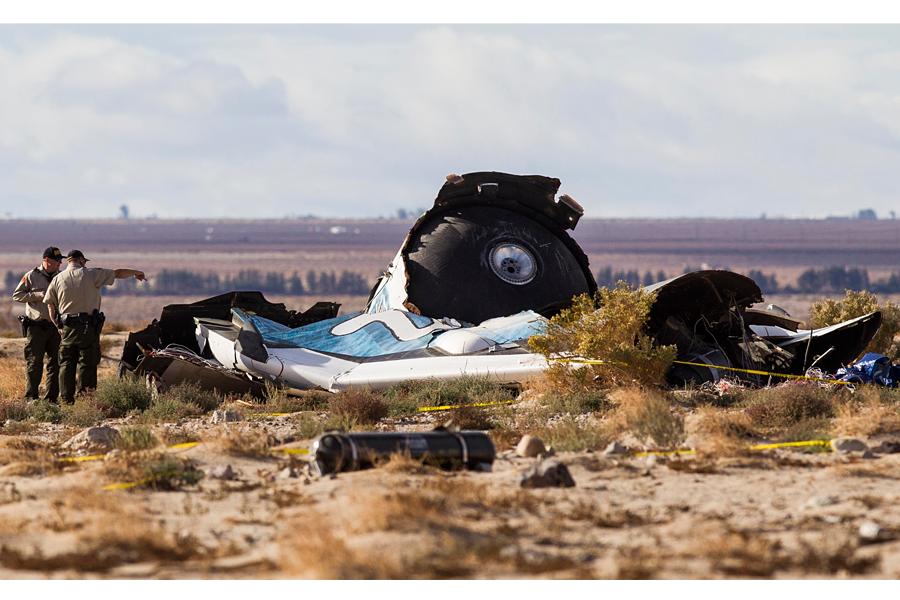SpaceShipTwo crash investigators: Feathering device unlocked early
Loading...
In a Monday afternoon press conference, acting NTSB chairman Christopher Hart confirmed that the safety lock on Virgin Galactic’s SpaceShipTwo feathering mechanism was prematurely unlocked moments before breakup. Hart also quickly stated that this would be the last on-site press conference. The NTSB is nearing the completion of data gathering and the team will be returning to Washington DC with the data to undertake the facts compilation followed by the analysis.
Hart reiterated that the test flight was rich in telemetry. He said that the supply of data could expedite the analysis but he cautioned that they still expect the investigation to take 12 months to conclude and release a final report. He also added that as analysis proceeds, the NTSB would provide updates and he encouraged interested parties including the public at-large to undertake analysis of the available data; however, he emphasized that the conclusions drawn would be based on NTSB analysis alone.
From the data released and statements by Hart during the press conference, it is now clear that the NTSB recognizes that the feathering was not to be deployed until SpaceShipTwo achieved mach 1.4. The statement that acting chairman Hart made appeared to be explicitly referencing the Flight Card – the plan of actions and constraints for the flight. If this was the specific wording on the flight card, then it would have permitted a pilot to interpret it in various ways.
Sunday, it was reported that SpaceShipTwo was flying at about Mach 1.2 when break up occurred. As a private pilot familiar with the impact that flight conditions have on operations of an aircraft, I would add that the SpaceShipTwo constraint of mach 1.4 for executing feathering is likely intended to be viewed by the pilots-in-control as the descent speed after SpaceShipTwo had achieved maximum altitude during a flight to the edge of the atmosphere. During descent, mach 1.4 would be achieved at a much higher altitude where the air density is much lower and stresses from the feathering would also be much lower; SpaceShipTwo is designed to feather with those environmental conditions. During previous tests of SpaceShipTwo when feathering was tested at low altitude, the vehicle was flying far below mach 1, i.e. subsonic. The vehicle in that flight regime had no difficulty withstanding stresses during the test of feathering. It should be emphasized that the strict rules under which the NTSB proceeds with an investigation does not allow the investigators to inject assumptions based on their past experience.
A timeline of events leading up to catastrophic breakup of SpaceShipTwo was stated by the NTSB acting chairman:
10:07:19: SpaceShipTwo is released from the carrier craft, WhiteKnightTwo
10:07:21 SpaceShipTwo’s engine starts
10:07:29 SpaceShipTwo reaches mach 0.94
10:07:31: SpaceShipTwo exceeds the speed of sound – mach 1.02. Between 10:07:29 and 10:07:31, the feathering safety was unlocked.
10:0 7:34: All telemetry was lost
The NTSB has also created a new team responsible for evaluating the Human-Machine Interface (HMI) on SpaceShipTwo. HMI is a discipline that has gained increased interest within several manufacturing sectors, particularly in aircraft cockpit design. The performance of modern aircraft, places greater demand on human performance. The formulation of a Human performance team evaluating the HMI of SpaceShipTwo indicates that the NTSB wants to assess the quality of the cockpit control panels and whether the configuration of switches contributed to pilot error.
While most of the debris is confined to a 5 mile swath of desert, Hart stated that debris has now been found as far as 30 to 35 miles from the immediate debris field.
Besides the apparent focus by the NTSB on the unplanned feathering, Hart stated that they are checking the subsystems of the spacecraft for integrity – pneumatics, flight control, electrical and so on.
Hart concluded the press conference by taking questions from reporters.
Q. Had the pilot been interviewed?
A. Not yet and not until he is fit to be interviewed.
Q. Was the flight card reviewed?
A. The NTSB has reviewed the flight card for procedures and constraints. According to Hart, the card stated to not release the safety lock of the feathering mechanism until mach 1.4.The flight card describes the steps that a flight crew is to take to complete a successful mission.
Q/A. Hart confirmed that 2 pilot actions were necessary for feathering. 1) Unlock the safety and 2) engage feathering lever. U.T. – Hart could not say if both pilots were necessary, that is, shared the two step process.
Q/A. A reporter contentiously asked Hart who was in the right seat. Hart stated that he did not know and also was unwilling to assume that it was the co-pilot, Alsbury. The reporter probing him further asked about his statements from Sunday. Hart agreed that he was mistaken to have assumed on Sunday that it was the copilot.
Finally, a review of the NTSB press conference video, placed on YouTube, presented a clarification as text on video. It stated that the co-pilot was residing in the right seat and was responsible for unlocking the feathering. At this preliminary stage of the investigation, it would appear that Alsbury’s death in the accident was due to his premature unlocking of the feathering mechanism. Hart did not state this but the circumstantial evidence so far is pointing in that direction.
Reference:
NTSB Press Conference Video, November 3, 2014
Universe Today contributing writer Tim Reyes is a former NASA software engineer and analyst who has supported development of orbital and lander missions to the planet Mars since 1992. He has an M.S. in Space Plasma Physics from University of Alabama, Huntsville.
Originally published at Universe Today.







